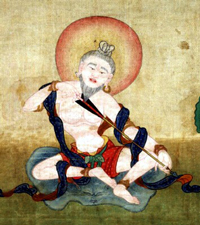
A GREATLY RENOWNED South Indian Buddhist scholar-monk by the a name of Rāhulabhadra was once passing through a town. As he maneuvered through the fair, he became mesmerized by a young woman who was straightening a piece of bamboo with three segments. Noticing her exceptional powers of concentration, he asked, “Young lady, what are you doing? Are you an arrow maker?” Moving in closer, he saw that she had one “eye closed and the other looking directly at the piece of bamboo. She was one-pointedly focused on her task, not distracted or disturbed by all the hustle and bustle of the marketplace. Nevertheless, she answered Rāhulabhadra, saying: “The intention of the Buddha can only be known through signs and skillful means, not through words and concepts.” In that moment, the three-kaya nature of buddha-mind became apparent to him through the signs and symbols the young woman, secretly a wisdom dakini, had displayed. A classical text relates the insights that arose in his mind:
Her one eye closed and the other open is the symbol of closing the eyes of consciousness and opening the eyes of wisdom; the bamboo is the symbol of the nature of mind: the three segments symbolize the three-kaya nature; straightening is the direct path; cutting the bamboo from the root is cutting the root of samsara; cutting the top of the bamboo is cutting ego-clinging; making four slots [for feathers] is the four unborn seals of mindfulness; adding the arrowhead at the end is the need for sharp prajna…”
Sudden awakening took place in his heart and he fully realized mahāmudrā. Recognizing that a wisdom ḍakinī was in front of him, he proclaimed, “You are not an arrow maker but a symbol maker!” From that time onward he followed her, abandoning scholarship and adopting the tantric path. He became known as Saraha or Sarahapāda, the “arrow shooter,” referring metaphorically to “he who has shot the arrow of nonduality into the heart of duality.” Saraha became the foremost mahāsiddha of the tantric tradition of Buddhism.
The dohā lineage in tantric Buddhism began when Saraha, also known as “the Great Brahmin,” started singing spontaneous songs of realization to his disciples: the king, the queen, and the people of the kingdom. Since then, the great siddhas of the mahāmudrā lineage have continued to express their realization and instructions to their disciples in pithy and spontaneous songs known as dohās.
Dzogchen Ponlop Rinpoche
from the forward to the book “Luminous Melodies” translated by Karl Brunnhölzl
published by Wisdom Publications 2019
